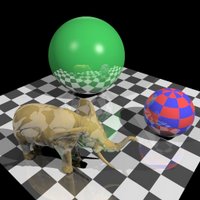Long time, no see.. erhm.. update.I haven't worked on the engine for quite some time now. I've had lots of other stuff to do.
This semester I've taken a course in
mobile computer graphics. A really great course that have given me a lot of useful knowledge about graphics hardware.
In course we had to do a mobile game project using the M3G (
JSR-184) Java API, and once again I teamed up with
Jesper Ek. We decided to do something different and we ended up doing a
OpenGL accelerated J2SE implementation of M3G. There was a competition to award the greatest game. We obviously didn't win, since we didn't make a game:) We received a Technical Achievement Award, however. The jury consisted of people from the industry, including folks from
Sony Ericsson,
TAT and
LUGG.
You can check out the project
here, and the other game entries
here (some are really cool!).
What about my engine then?It's discontinued. Yep. Discontinued.
I have decided to not develop it any further and instead start on a completely new engine using Microsoft
XNA!
My old engine was 100% graphics API independent and that's
of course a good thing. However,
being a single developer with very little spare time, that resulted in slowing down the project considerably. By selecting only one API, I will be able to speed up the
development and focus on the cool stuff.
XNA is
of course the obvious
choice.
It still lacks some important
functionality, but I'm very
confident that that will be addressed when it's finally released.
Micsosoft seems very serious about
XNA and I think it has a bright future.
And yeah, I've "upgraded" to the new
Blogger beta, so I changed to a new blog template. Sweet.
 Going sloooow.
Going sloooow.





































